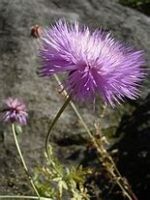 Native to Asia Minor, this clump-forming cool climate annual is a member of the aster family, Asteraceae, that also includes daisy, yarrow, and lettuce. It grows 1-3′ tall and has gray-green undivided, toothed basal leaves up to 4″ long and lobed or divided leaves on long slender stems that carry terminal thistle-like flowerheads from late spring into summer. The 2″ flowerheads have a honey sweet fragrance and are composed of narrow petaled flowers that are lilac to rose and surrounded by an involucre of small entire bracts. Cultivars are available that vary most significantly in plant size and flower color. The plants are favorites for cottage gardens and the flowers are excellent in the vase. The genus name, Centaurea, is from the Greek word kentauros meaning centaur and refers to the myth that a plant in this genus healed the centaur Chiron, a half-man- half horse creature of Greek mythology. The specific epithet, moschata, comes from the Greek word móskhos meaning musky, and refers to the fragrance.
Native to Asia Minor, this clump-forming cool climate annual is a member of the aster family, Asteraceae, that also includes daisy, yarrow, and lettuce. It grows 1-3′ tall and has gray-green undivided, toothed basal leaves up to 4″ long and lobed or divided leaves on long slender stems that carry terminal thistle-like flowerheads from late spring into summer. The 2″ flowerheads have a honey sweet fragrance and are composed of narrow petaled flowers that are lilac to rose and surrounded by an involucre of small entire bracts. Cultivars are available that vary most significantly in plant size and flower color. The plants are favorites for cottage gardens and the flowers are excellent in the vase. The genus name, Centaurea, is from the Greek word kentauros meaning centaur and refers to the myth that a plant in this genus healed the centaur Chiron, a half-man- half horse creature of Greek mythology. The specific epithet, moschata, comes from the Greek word móskhos meaning musky, and refers to the fragrance.
Type: Annual
Bloom: Lilac to rose thistle like flowerheads from late spring through summer
Size: 1-3′ H x 1′ W
Light: Full sun
Soil: Average, moderately moist, well-drained
Hardiness: Not relevant ; best in cool climates
Care: Deadhead to encourage rebloom; may need staking,
Pests and Diseases: None of significance
Propagation: Seed directly into the garden as plants don’t transplant with difficulty.
Companion Plants: Hollyhock, daisy, zinnia, catmint
Outstanding Selections:
‘Antique Lace’ (pastels of pink, lilac, or lavender flowers, 2″ tall)
‘Dairy Maid’ (yellow flowers, 1-2′ tall)
‘Imperialis’ (white to yellow-pink to carmine to purple flowers, 3-4′ tall)
Lucida’ (dark red flowers, 2′ tall)
‘The Bride’ (white flowers)
Photo Credit: Wikipedia